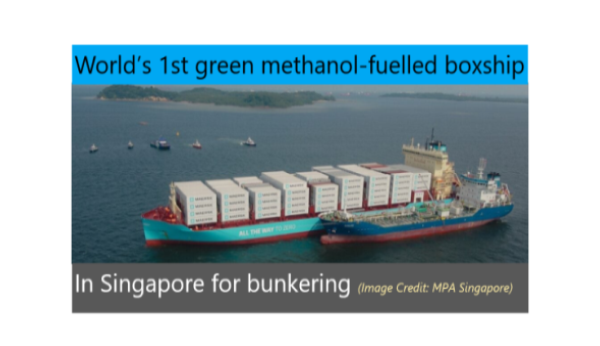The world’s first green methanol-powered containership owned by shipping giant Maersk has arrived in Singapore for bunkering. The first ship-to-containership methanol bunkering operation of the container vessel – which was refuelled with approximately 300 metric tonnes of bio-methanol – was completed on 27 July at the Raffles Reserved Anchorage in Singapore, with the support of the Maritime and Port Authority of Singapore (MPA).
During the operation, researchers from the Cambridge Centre for Advanced Research and Education in Singapore flew drones equipped with methanol detectors that have plume modelling capabilities and infrared cameras, to augment the detection of potential methanol leaks into the atmosphere and methanol flames in an event of an accidental leak.
SunGas Invests in Plant to Power Maersk’s Ships
SunGas Renewables is forming a new subsidiary named Beaver Lake Renewable Energy (BLRE), which will construct a new green methanol production facility in Central Louisiana. The plant is expected to produce nearly 400,000 metric tons of green methanol per year for marine fuel for Maersk’s fleet of methanol-powered container vessels. BLRE is expected to invest approximately US$2 billion to construct the project, which is set to begin in late 2024.
Maersk’s Target
To meet the 2040 target of net-zero greenhouse gas emissions in time, Maersk aims to transport a minimum of 25% of ocean cargo using green fuels by 2030, compared to a 2020 baseline. The carrier currently has 25 dual-fuel vessels on order ranging from 2,000 TEU container capacity to 16,000 TEU. They expect that the full fleet of green fuel-powered vessels will be delivered and operational by 2027.
Go-ahead for Methanol in China
In related news yesterday (27 July), China is also getting in on the act with its first methanol bunkering ship being given the green light, after approval was granted to Zhejiang Seahead Ship Design and Research Institute Co. Their methanol-fuelled bunkering ship design has been developed in response to the industry’s growing demands for methanol as a marine fuel. The vessel boasts a maximum methanol filling capacity of 7,500 tonnes and is designed to be ‘versatile’ – capable of running on both fuel oil and methanol fuel.
Progress on LNG Powered Vessels
As an alternative to methanol, Bio-LNG offers a net-zero pathway for shipowners who have chosen this method to cut their emissions. Bio-LNG is now available in almost seventy ports worldwide, including in Singapore, Rotterdam, and the US east coast, according to an analysis of the green LNG bunkering market published released yesterday by SEA-LNG – a multi-sector industry coalition that promotes LNG as a marine fuel.
With a current global fleet of 355 LNG-fuelled vessels (excluding the actual LNG carriers), annual production of biomethane, from which bio-LNG is produced, is currently around 30m tonnes or 10% of shipping’s total annual energy demand. It could be available in sufficient quantity to fully decarbonise approximately 13% of the global shipping fleet by 2050.
Read our related articles: Cargo Vessels: Fuels of the Future and Evergreen Grows Greener and Bigger.
For more information about international shipping, contact us here at Colless Young. As licensed Customs Brokers and International Freight Forwarders we offer correct, professional advice on all your import and export trade transactions. We are based in Brisbane and provide a complete range of logistics services, for both airfreight and sea cargo through all Australian ports and airports.

